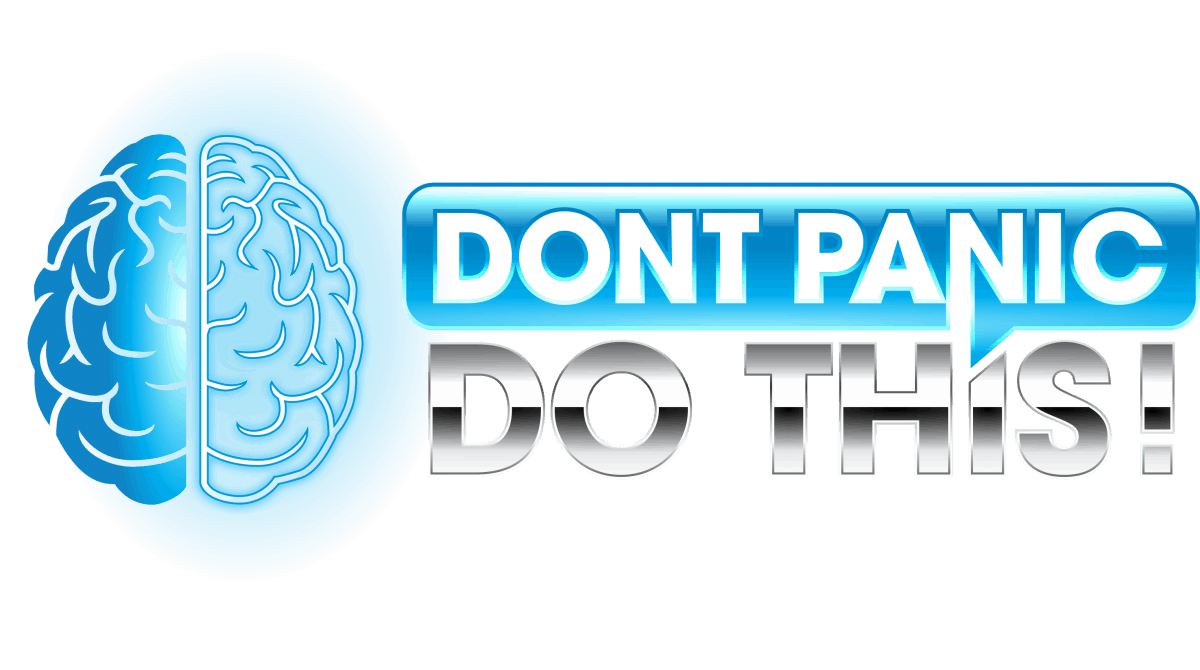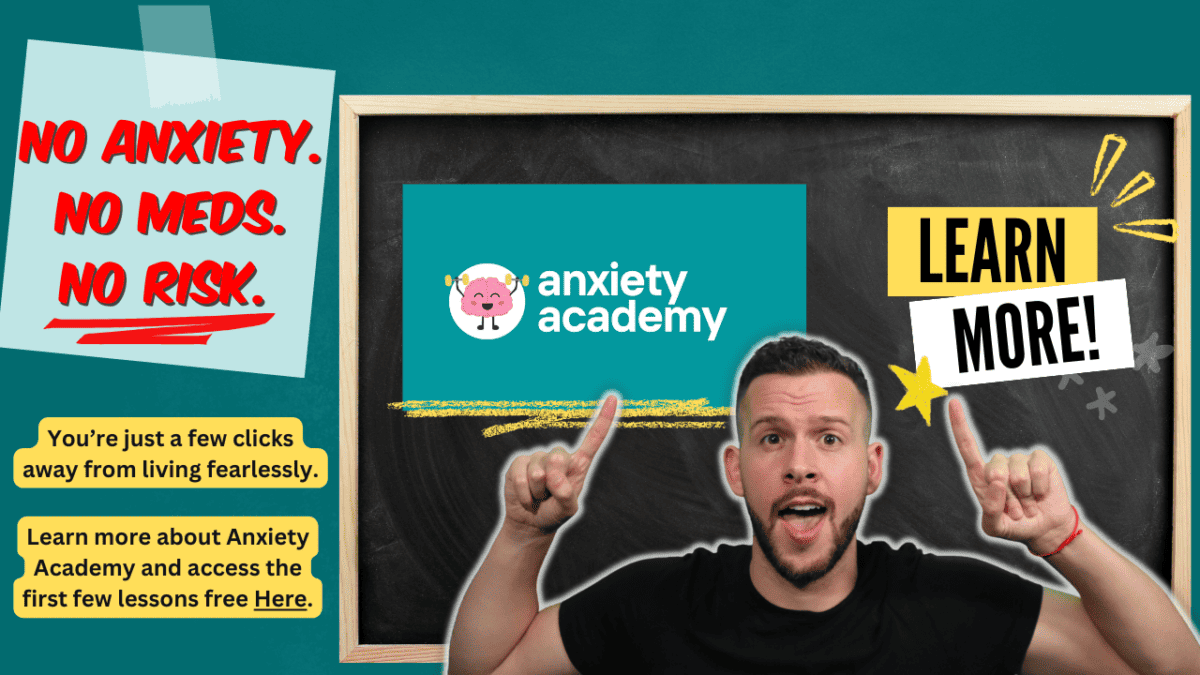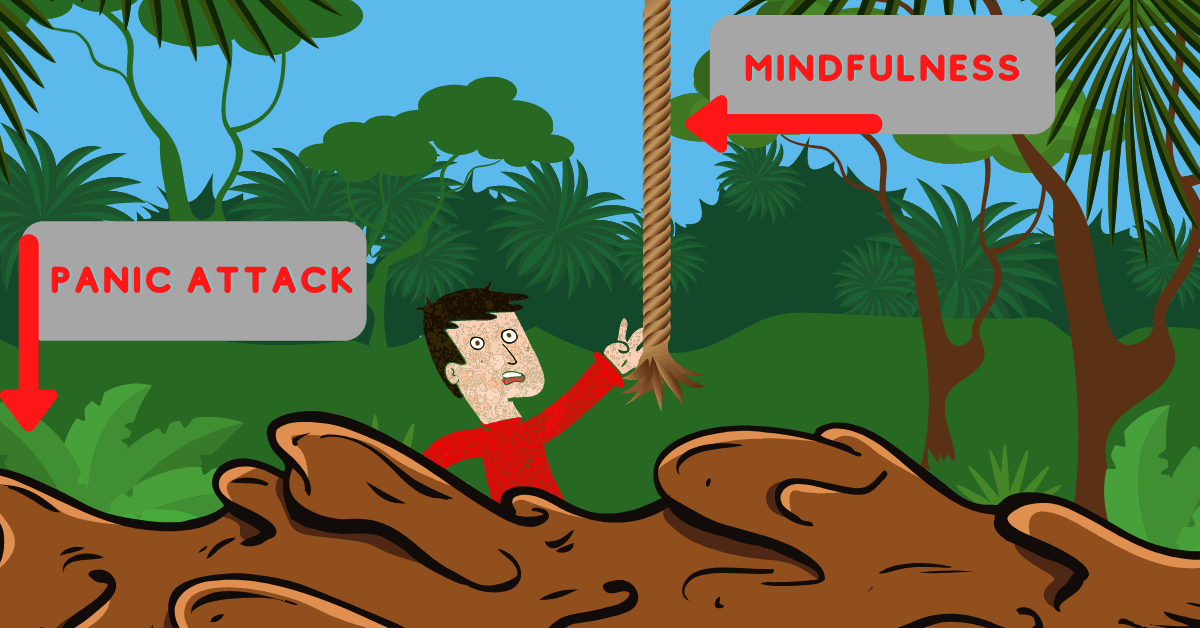When I first started having panic attacks as a teenager, I was desperate to learn any way of getting them under control. Somehow, I completely overlooked the possibility of meditating for panic attack and anxiety relief. Years later, I finally gave the subject some real attention. Can meditation really help with panic attacks and anxiety?
While often overlooked as a solution, meditation is a powerful method for managing panic attacks and anxiety. Meditation works like an exercise for the brain, training the mind’s ability to focus, pay attention, and exert self-control. Meditation is easily one of the best coping mechanisms for panic attacks and anxiety.
I struggled with severe panic attacks for several years before getting my panic disorder under control. In fact, I didn’t even attempt meditation until more than 10 years after my first panic attack. This was mostly due to my own misconceptions and ignorance about meditation.
Don’t make the same mistake I made!
Meditating for panic attack and anxiety relief can be a powerful coping mechanism as you take back control of your life. Don’t leave this tool untouched.
Stick with me through the rest of the article, and I’ll tell you absolutely everything you need to know to use meditation for panic attacks and anxiety.
Let’s get started.
Meditation for Panic Attacks and Anxiety: How Does it Help?
At its core, meditation is about learning to control the mind. While meditating, we train our ability to purposefully focus and redirect our thoughts. Additionally, meditation can also be used to improve one’s anxiety symptoms, mood, sleep, pain tolerance, and discipline.
The ability to purposefully focus and redirect our thoughts is especially important for people with anxiety since anxiety disorders typically involve the inability to calm and control the mind.
We experience anxiety when something sets off our fight or flight response. The amygdala tells us to panic and suddenly it's impossible to slow our thoughts or relax.
Meditation takes us in the opposite direction.
We are taking a few moments to practice having control over our thoughts.
For first-timefight-or-flight meditators, especially anxious ones, this can be a difficult process. The mind may constantly try to wander away from the meditation.
Over time, however, meditation becomes easier, as we learn how to better control our own thoughts and incorporate effective calming breathwork techniques.
Due to neuroplasticity, repeated instances of anxiety can lead to a more active amygdala, making us more prone to anxiety over time. Habitual meditation, however, can actually shrink the amygdala and increase cortical thickness in the brain, making us less prone to anxiety and more receptive to the benefits of meditation over time. [1] [2]
In other words, meditation gets easier and more effective the more you meditate, while training you to turn off your anxiety.
The last thing an anxious person may want to try is sitting still with their thoughts, but it's anxious people who can benefit the most from meditation.
The 3 Meditation Myths
If you’ve never meditated, chances are you might have some of the same hang-ups that I did before trying it. When most people think about meditation, they tend to think about ancient Buddhist monks and elusive mysticism. Skeptics might easily dismiss meditation as placebo, concluding that it just isn’t for them.
The sad fact is, meditation is one of the most poorly branded exercises to ever exist. If meditation had a PR and marketing team they’d have been fired long ago. However, one must consider the fact that many health and fitness trends such as bodybuilding were also all but unheard of until the past few decades.
Although it’s had a slow and rocky start, meditation has finally begun to pick up steam in Western culture. It’s finally getting the respect it deserves, and you’d be doing yourself a disservice to overlook such a powerful mental resource and anxiety coping mechanism.
But before we go any further, I’d like to clear up a few of the biggest myths surrounding meditation – these are the things that I had wrong in the beginning.
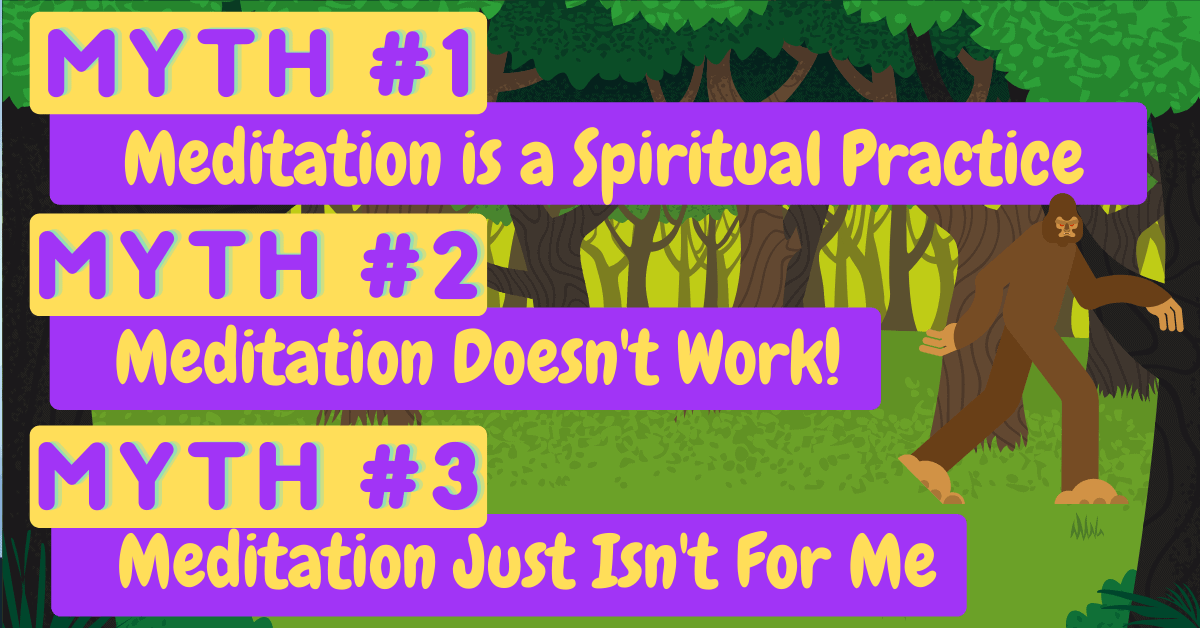
Myth #1 – Meditation is a Spiritual Practice
There was a time when I’d have never considered trying meditation for anxiety.
I used to think meditation was something for hippies and monks; not for people like me.
As with practicing yoga for mental health, many people have a hard time separating the spiritual from the physical when it comes to meditation. This can turn some people off right away so that they never experience the psychological benefits of meditation.
But the fact of the matter is...
Meditation is not just for those seeking spiritual or religious growth.
Not even close.
While true that many religions do incorporate meditation into their practices, meditation is by no means an innately religious act. Meditation is incredibly effective, which is why so many different belief systems have found ways to intertwine various meditative acts into their rituals. But meditation in and of itself can be an entirely secular act, without any spiritual connotations whatsoever.
This article will only be referring to secular meditation – nothing spiritual or religious. You may certainly find ways to incorporate your own belief system if you choose, but this is not required to derive benefits. Anyone can meditate and experience real, tangible benefits over time, especially if they are meditating for anxiety relief.
Myth #2 – Meditation Doesn’t Work!
If you’re naturally skeptical like myself, you may initially assume that meditation just doesn’t work. When I first heard about meditation, a lot of the people I saw doing it were the same people adorning themselves with “healing crystals” and using homeopathic remedies; it immediately put me off.
But, once you remove all the crazy pseudoscience tacked on by various subcultures, you’re left with something that can actually bring scientifically measurable results. A systematic review and meta-analysis of 47 trials with 3515 participants concludes that meditation programs can result in reductions to multiple negative dimensions of psychological stress. [3]
Studies consistently find meditation to be helpful for reducing anxiety symptoms. [4]
Dismissing meditation as ineffective is just plain lazy. Scientific studies show time and time again that meditating for anxiety relief can be quite effective.
Myth #3 – Meditation Just Isn’t for Me
Like I said before, I used to think that meditation was something reserved for hippies and monks; and I couldn’t have been more wrong.
Saying that meditation isn’t for you is a lot like saying that physical exercise isn’t for you.
Meditation is an irreplaceable practice that covers several vital aspects of your mental health. As far as I’ve been able to tell, there really is no substitute or alternative capable of doing what meditation does for us.
Large corporations and even the U.S. Military are taking advantage of meditation to increase cognitive resilience and performance while decreasing stress and anxiety. If that’s not cool enough for you, check out the STRONG project to see how the military is using resilience training to provide soldiers with “mental armor.”
If meditation is credible enough for organizations like Apple, Google, and the U.S. Army, it should certainly be credible enough for you.
After some trial and error with different forms of meditation, you might conclude that a certain form of meditation is not your favorite; much like someone might prefer running over weightlifting, or hiking over swimming. But, to dismiss all forms of meditation as a whole (especially before trying them) would be a mistake.
Later in the article we will discuss some of the different types of meditation. You’ll be able to experiment a bit and find exactly which form of meditation is for you.
Different Types of Meditations for Anxiety
Meditation can be confusing at first since there are so many different forms of it.
Just a quick Internet search can pull up hundreds of different types of meditations, all serving a different purpose. Some of these might include:
- Sitting Meditations
- Walking Meditations (pacing, hiking, walking a labyrinth, etc.)
- Guided Meditations
- Repetition-based Meditations (The Rosary, mantras for anxiety, etc.)
- Body Scanning
- Progressive Muscle Relaxation (PMR) Exercises
- Mindfulness Meditations
- Focusing Attention, Thinking of Nothing, etc.
- and many others
With so much variety, it's easy to get overwhelmed; especially if you're new to meditating. Fortunately, there's really no need to dive in too deep if you're just meditating for anxiety relief.
*Remember: There are also thousands of different exercises we can do in at the gym. But we don’t let this overwhelm us, and we certainly don’t need to know how to do all of them in order to get a good workout in!
My advice starting off is not to overwhelm yourself. Don’t try and overanalyze meditation, or to understand every different type of meditation. Just learn some of the basic ways to meditate and stick with them for a while. I’m no expert myself, but this still doesn’t stop me from benefiting from meditation. I’ll try and build a foundation for you here; if you decide you want to stick with meditation for panic attacks and anxiety, I’ll point you toward some additional resources near the end of the article.
Here’s what I consider important to understand when starting out:
Sitting Meditations vs Walking Meditations
Before you even start to meditate, you’ll probably be wondering what kind of position you should be meditating in. For first-timers, I think it’s pretty commonplace advice that you learn how to meditate in a seated or lying position. If you’re doing a guided meditation, the speaker may specify which position is recommended for that particular meditation. For most meditations, you can practice them in whatever position is comfortable to you.
Generally speaking, as long as your physical reality isn’t interfering with your mental practice of meditation, I don’t think it matters too much what position you are in. Personally, I prefer walking meditations over sitting meditations. I will sometimes meditate while going for a walk because my mind tends to work better while I’m moving (the fresh air and sunshine is another plus). Walking meditations may not be optimal for everyone, but you certainly should not feel limited to sitting on the floor of your living room while meditating.
If you decide to try a walking meditation, just remember to be safe and mindful of your surroundings.
Guided Meditations
When you hear the term “guided meditation,” this is just referring to a meditation in which someone (either a person or a recording) is walking you through your meditation. This can involve any combination of mindfulness practices, visualization, or other meditative strategies.
In my experience, guided meditations can be hit-or-miss, since the quality of any one guided meditation can vary considerably. It’s also important to make sure that the purpose of the guided meditation is in-line with your meditation goals. For example, a guided meditation with the intent to prepare you for sleep is probably not in-line with your goals at 2pm in the afternoon.
YouTube and many digital apps offer guided meditations (some free, some premium) for just about any purpose you can imagine. You can use guided meditation for panic attacks and anxiety relief, or you can use them to help you feel better after a tough day. Personally, I find guided meditations to be pretty nice to fall asleep to.
Here's a good guided mindfulness meditation I found for free on YouTube:
Repetition-Based Meditations
Some meditations incorporate a repeated sound or phrase, often called a mantra. Probably the most famous mantra you may have heard of is “Om mani padme hum,” from Buddhism. Another example could actually be praying The Rosary in Christianity. But, like I said before, meditation in and of itself can be a secular act. Non-spiritual mantras may also be used, and could effectively be any word, like “Calm,” or even a phrase, like “I am relaxed.” For some people, a mantra can help to increase concentration and focus.
If I’m being honest, I have very little experience with incorporating a mantra or repetitive phrase into my meditations; I prefer meditating without them. This may be something you wish to try out for yourself, but remember it is not a required component of meditation.
Body Scanning Meditations
Body scanning involves lying down and bringing your attention to a specific part of your body. Start at the top of your head or the bottom of your toes, and slowly work your way across the whole body. Stop at each specific body part, bringing your full attention and awareness to how that part of your body feels. Take note of any sensations – tingling, numbness, temperature, pain, pressure, etc. – before moving on to the next body part.
For many people, performing a simple body scanning meditation can help with relaxation and stress relief.
Progressive Muscle Relaxation (PMR) Exercises
Progressive muscle relaxation is an excellent coping mechanism to help with panic attacks, stress, and anxiety. Much like Body Scanning, PMR has you moving from muscle group to muscle group across your body; except now, you are actively tensing and relaxing these muscle groups. I'll explain how to do this in the following section.
Progressive Muscle Relaxation can be an effective coping mechanism for stress and anxiety relief, or to help you relax, fall asleep, or decrease general tension.
Mindfulness Meditations
If you are depressed you are living in the past. If you are anxious you are living in the future. If you are at peace you are living in the present.
Mindfulness meditations help us to shift our focus to the present.
They can be as simple as sitting, in silence, and focusing on our breathing.
How many breaths does it take before your attention wanders away from your breathing?
For anxious individuals new to meditating, probably not very many.
This is an excellent meditation for anxiety attacks because it helps us to break some of the bad habits associated with anxiety disorders.
When we're anxious, negative thoughts and emotions try to break into the forefront of our consciousness. Naturally, we try to avoid these experiences or otherwise distract ourselves from them out of fear.
Practicing mindfulness meditation for panic attacks and anxiety can help us learn not to fear these experiences. Rather, we allow the thoughts to come and pass, harmlessly, and we return our mind to our meditation.
Over time, we learn that anxiety is not something that needs to be feared or avoided.
Meditating for Panic Attacks and Anxiety
Alright, so I know I just laid a lot on you with all that meditation jargon. It can be pretty tough to follow, but I wanted to be as thorough as possible with the methods I’m personally familiar with. With that said, if you’re specifically interested in meditation for panic attack and anxiety relief, look no further.
Side note: Check out this post to learn how to stop anxiety attacks quickly.
If you only ever try two meditations for panic attacks, the two I recommend are:
- Mindfulness Meditations
- Progressive Muscle Relaxation (Tense and Release)
To be fair, some guided meditations can also be pretty useful to help with stopping panic attacks; but for now, let’s just focus on mindfulness and PMR.
In the previous section, I explained a bit about how to practice meditating for mindfulness and how to use progressive muscle relaxation. Now, I’d like to elaborate on each method a bit and explain how we can use them to help us better cope with panic attacks and anxiety.
Mindfulness Meditation for Panic Attacks and Anxiety
If you’ve had a panic attack before, you know exactly how terrible they feel. It’s like a persistent fear or worry that you can’t pull your mind away from. Your thoughts start to spiral down into a rabbit hole, and the harder you fight, the deeper you’re pulled into the vortex.
The reason why mindfulness meditation is easily one of the best exercises for someone who suffers from panic attacks and anxiety is because it teaches you how to take a thought, acknowledge it, and then let the thought pass without judgment. If you think about panic attacks and anxiety like quicksand, mindfulness is the rope you grab to pull yourself out.
Mindfulness meditations are probably better for the long-term benefits than for the short-term, so this is something you should stick with in order to see lasting improvements over time.
As you know, there are so many different ways to meditate, but here’s how I recommend getting started with mindfulness meditations:
- Set a timer that will indicate when your session is over (10 minutes is probably ideal for beginners, but if you’re feeling apprehensive, even just 1 minute per day is fine to build the habit).
- Sit or lay comfortably and alone in a quiet room.
- Turn your focus toward your breathing and hold it there. Note how each inhale feels as it comes in through your nose, and how each exhale feels as it exits your mouth. Study the sensation with an almost scientific level of curiosity (If focusing on your breathing makes you uncomfortable, you can choose another focus object: a constant background noise, a specific sensation on your body, a mantra or focus word, etc.).
- Thoughts will occasionally pop up, this is normal. Briefly acknowledge their presence, then let them pass and return your focus to your breathing (or other focus object).
- Continue this process until the end of the meditation session.
The important thing to remember with mindfulness meditations is that these intrusive thoughts are normal and expected. You are not failing in your meditation when thoughts pop up, it is actually a part of the exercise. You are training your ability to let thoughts pass non-judgmentally and return your focus. This is a skill that, over time, can help you to dismiss the kind of catastrophic thinking that takes hold during anxiety attacks.
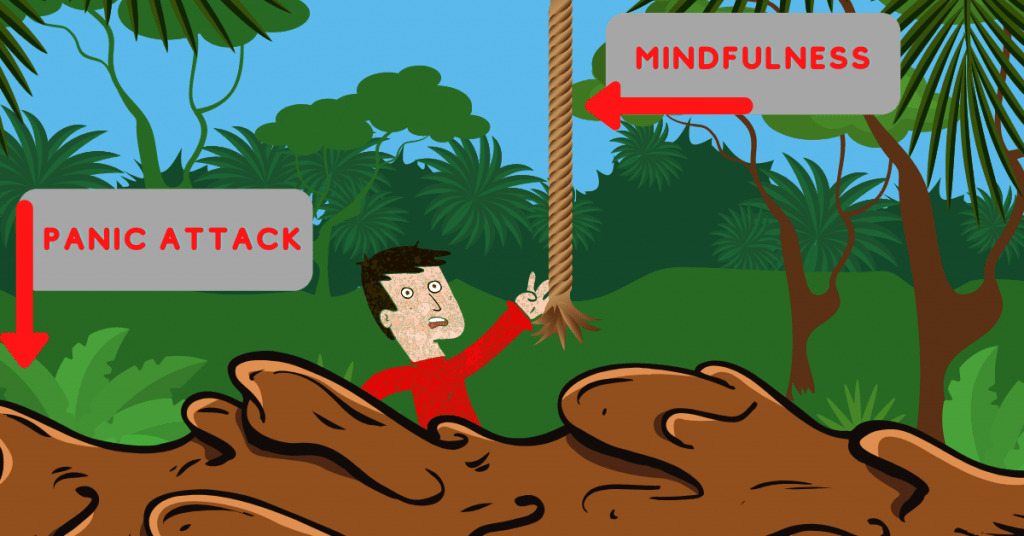



Progressive Muscle Relaxation as a Coping Mechanism
As mentioned earlier, progressive muscle relaxation has us actively tensing, and then relaxing, various muscle groups throughout our body. Here’s how it can be done:
For this exercise, the muscle groups may include:
- Hands
- Forearms / Wrists
- Upper Arms
- Shoulders
- Forehead
- Eyes / Nose
- Cheeks and Jaw
- Mouth
- Neck
- Chest
- Back
- Stomach
- Buttocks
- Thighs
- Lower Legs
If it is difficult for you to isolate any of these muscles, feel free to lump them into a larger group.
Now, try this:
- Take a deep breath in and tense the first muscle group for 4 to 10 seconds
- Completely let your breath out, immediately relaxing all muscles
- Relax for 20 seconds, taking note of how different your muscles feel when they are tensed vs when they are relaxed
- Continue this with each muscle group across your body
The goal of this exercise is to help decrease any stress or tension built up in the body. Because our body takes cues from the mind, when we are anxious, our muscles may be tense. We can reverse engineer the link between our mind and body by manually tensing and relaxing different muscle groups, so that our mind is able to take a cue from the body and feel more relaxed by the end of the exercise.
Try doing this a few times a day, and experiment with variations until you find what works best for you. Progressive muscle relaxation can be an incredible coping mechanism; once our mind learns to associate the exercise with a state of relaxation, it can be a great tool to pull out to help us calm down during an anxiety attack. Coping mechanisms like this will be important to have when it comes time to try and conquer our panic attacks for good with progressive exposure therapy.
Taking Meditation to the Next Level
Despite all the research and experimentation I did for this article, the fact of the matter is that we’ve barely even scratched the surface here. The progressive muscle relaxation exercise and the mindfulness meditation for panic attacks and anxiety will probably be enough for most people. However, if you’re hungry for more, here are some good resources to check out:
Meditation Book Reviews
- 10% Happier – This is the book I recommend to skeptics, since the author himself was initially a huge skeptic of meditation. It’s all about anchorman Dan Harris’ journey with panic attacks, and how he eventually discovered meditation as a solution.
- Meditation for Fidgety Skeptics – This is the sequel to 10% Happier. This book is a bit more practical, and helps new meditators by walking them through some different mindfulness meditations while teaching how to build a habit around meditation.
- The Meditation Bible – I actually bought this book years ago but hadn’t read it until recently. Where the other books are more theoretical, this book is purely practical. It takes you through tons of different meditations, explaining each in detail. Perfect for anyone trying to find the right meditation style.
Recommended Products for Meditation
None of the below products are necessary for meditation, so don’t feel like you need to rush to buy any of them. These are just some of the tools I’ve used that I feel can help to enhance the experience.
- Essential Oil Diffuser – This is the one I recommend the most; I actually just gave one to my cousin as a gift a few weeks ago. Essential oil diffusers do an awesome job of setting a relaxing mood. I personally find Lavender, Eucalyptus, and Tea Tree Oil to be the most relaxing scents. The diffuser I linked to comes with a bunch of oils, so you could experiment a bit and see which ones you like for next time.
- Incense – While I generally prefer the clean feel of an oil diffuser, incense does a uniquely good job of creating an atmosphere you feel like you should be meditating in. Try it out if you’d like, but if you already have an oil diffuser you won’t need both.
- Tibetan Singing Bowl – Some meditations call for using a Tibetan singing bowl. They make a pretty unique sound which can serve as a unique and effective focus object. This is not necessary by any means, but could be cool to check out. I do not own this one personally, but it’s the highest ranked one I saw on Amazon.
Guided Meditations for Panic Attacks and Anxiety:
As much as I would love to create some guided meditations for panic attacks and anxiety for you guys, I just don’t have the soothing voice or temperament to do so.
Instead, I’m going to suggest you check out:
- Headspace (and the Headspace app)
- Mindful.org
- YouTube (just search for “Guided Meditations”)
Those sites handle guided meditations for panic attacks and anxiety better than I ever could, so give them a shot!
